This is a Beira II, a 35mm rangefinder camera produced by Kamera-Fabrik Woldemar Beier in Frietal, Germany starting in 1935. The Beira II is an upgraded version of the original Beira camera, adding a porro prism focusing prism to the top plate of the camera. Despite the use of a prism, the Beira II is not a reflex camera. The prism is coupled to the taking lens and moves forward and backward as the lens is focused. Light passing through the prism comes into focus, allowing the user to see a magnified partial view of what will be captured on film. In some ways, the Beira II is like a hybrid between a rangefinder and SLR all in one. Despite its innovative design, the Beira II did not catch on, and no other camera was ever made like it.
Film Type: 135 (35mm)
Lens: 5cm f/2.9 Steinheil München Cassar uncoated 3-elements in 3-groups
Focus: 1 meter to Infinity
Viewfinder: Scale Focus with Separate Focusing Porro Prism
Shutter: Compur Rapid Leaf
Speeds: T, B, 1 – 1/500 seconds
Exposure Meter: None
Battery: None
Flash Mount: None
Other Features: None
Weight: 620 grams
Manual: None
How these ratings work |
The Beier Beria II is a camera unlike any other. It is equal parts rangefinder, SLR, and TLR, all in a strange looking but attractive pre-war “nickel and leather” body. The inclusion of a Compur Rapid shutter and good Steinheil Cassar lens means the camera is capable of terrific images, but the best part is the “focusing prism” on top of the camera, which allows you to “see” focus like an SLR, but still requires you use a separate window for composing your image. These cameras are incredibly rare, and when found are expensive, but represent one of the coolest cameras I’ve ever used. | ||||||
| Images | Handling | Features | Viewfinder | Feel & Beauty | History | Age | |
| 2 | 1 | 2 | 2 | 2 | 1 | 40% | |
| Bonus | none | ||||||
| Final Score | 14.0 | ||||||
History
The story of the Beier Beira II starts with its company founder and namesake, Woldemar Beier. Beier was born on March 30, 1886 as the son of an iron worker. As a teenager, he worked as an apprentice at Kamerawerke Ferdinand Merkel in Tharandt, Germany, near Dresden. Merkel founded his business in 1900 as a camera repair workshop, repairing field cameras and other photographic equipment being sold at the time.
Merkel would eventually expand his business to camera distribution and in the 1920s to manufacturing plate and box cameras like the Phönix, Minerva, and Triumph. In 1932, Kamerawerke Merkel Tharandt would be absorbed into Kamerawerke C. Richter Tharandt and produce models like the Reflecta TLR.
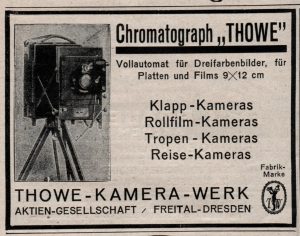
In 1914, after spending a little over a decade working for Ferdinand Merkel, Woldemar Beier would leave the company to start his own workshop, which he called Thowe Kamerawerke A.G. Thowe would manufacture a variety of folding plate and roll film cameras of various sizes, including the Thowette, a compact folding “vest pocket” style camera which produced 3cm x 4cm images on 127 film.
Although most of Thowe’s designs were pretty typical of the era in which they were made, one way in which Thowe was one of the first German companies to heavily export its cameras to Japan, where they gained a small following.
In the years following the first world war, Germany’s economy was in shambles and many German manufacturers found it difficult to stay in business, so in April 1923, seeing an opportunity to start over with a new company, Woldemar Beier would leave Thowe to form another camera workshop which he named after himself, Kamera-Fabrik Woldemar Beier. The new Beier company would largely take over where Thowe left off, building small plate and roll film designs, similar to what many other companies in the Dresden area were making.
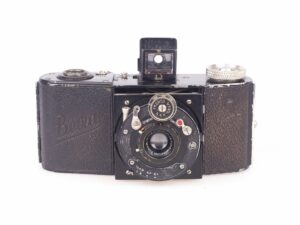
Around 1930, Woldemar Beier took notice of a new type of miniature or “Kleinbild” cameras that were being designed to use 35mm wide bulk film. Of course the Leica, made in Wetzlar by Ernst Leitz was leading the charge, but within a few years, competitors using the same or very similar film would be released by Zeiss-Ikon, Certo, Welta, and Kodak.
Beier would begin work on their own “Kleinbild” camera, with a design created by a precision mechanic named Bruno Plickert. A prototype of Plickert’s new camera would be shown at the 1931 Leipzig Spring Fair called the Beika. The camera was presented as an economic alternative to the Leica, but unlike the Leica, it exposed 40mm x 30mm images on unperforated 35mm bulk film. It’s name Beika, likely was a play on Beier and Leica, which likely ruffled some feathers at Enrst Leitz, makers of the Leica, as when the camera finally made its debut in 1932, was renamed the Beira. Strangely, despite being described as a cheaper alternative to the Leica, many early Beiras were equipped with an E. Leitz Elmar 5cm f/3.5 lens.
Although a capable camera, the Beira’s use of unperforated film and special cassettes proved to be unpopular, so in 1933 a revised model called the Beira Ia was released which replaced the flip up viewfinder with a tubular one, but more significantly, the camera could now use “kine” double perforated 35mm film, just like the Leica and other 35mm German cameras. To accommodate the new film, the gate was reduced to 24mm x 36mm and a rubber film spool was replaced with a traditional geared shaft for the exposure counter. The camera still used proprietary cassettes, however.
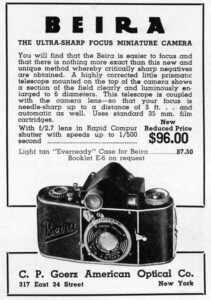
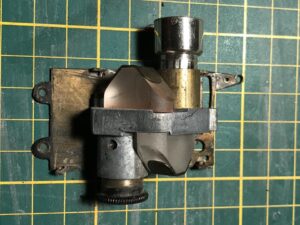
In 1935, a new model called the Beira II would be released which for the first time in a 35mm camera used a porro prism viewfinder. Unlike other prism cameras that would follow, the Beira II was not a reflex camera. Instead, the Beira’s prism was housed under a triangular top plate and had a separate viewfinder which could only see a small circular image. A lens attached to the front of the prism housing was coupled to the taking lens, so that when the camera was focused, the prism’s lens would also move and allow light to pass through to the prism forming a focused image which allowed the photographer to “see focus” like in a normal SLR.
Although it is unclear of how Beier advertised the camera, but in a 1938 ad from C. P. Goerz American Optical Company, the Beira was described as having a prismatic telescope. I think a more accurate term for the camera is to describe it as a rangefinder camera, as the porro prism viewfinder only shows a magnified central circle for focus, it cannot be used to compose the entire image.
Regardless of how it was described either in Germany or the United States, when imported to the US, the price of the camera was listed at $96, which when adjusted for inflation, compares to around $2100 today making for quite an expensive camera.
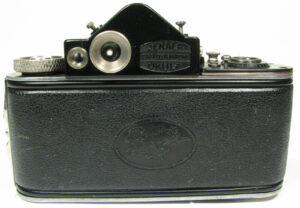
Most references to the Beira II online describe it as having an “Okula” prism, with many referring to the model as the Beira Okula. At least a few images I found of the camera online show a logo stamped “Jenaer Einstellfernrohr Okula” on the rear of the prism next to the eyepiece. The camera being reviewed in this article lacks this logo, so I am uncertain of how many were produced with or without the logo, or which came first.
The presence of this logo confirms the term “Okula” in reference to the camera, but I have yet to see this printed in any documentation from the era. Not even the US ad shown above makes this reference. If the prism was separately sold as the “Okula” or made by a company called Jenaer Okula, I have found no reference to it. Perhaps this is a name unofficially given by collectors years later as an attempt to differentiate it from the earlier model. In any case, if I ever learn more, I will update this review.
Like most German optics companies, Beier would halt production of cameras around the start of World War II to transition to making products for the German war effort. Beier’s factory would be destroyed and in 1945 after Germany’s surrender, Woldemar Beier would begin the long and difficult process to restore his factory. With no resources and very little money, Beier used his knowledge of manufacturing and precision mechanics to start a small business repairing cameras, household appliances, and other small devices.
Soon after, Beier began producing everything from potato peelers to shoehorns and whatever else would bring in money to put towards his goal of building cameras again. Eventually, Woldemar Beier would get enough capital to start production of the prewar Beirax folding camera. The camera would mostly be unchanged from the earlier version with the only differences being a different selection of shutters and lenses which were available at the time.
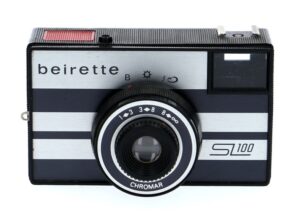
Throughout the 1950s, Beier would continue to grow, producing a lineup of inexpensive medium format and 35mm cameras like the Beierette and its variants. Eventually, like most East German camera companies, Beier would be taken over by the East German state government and become part of VEB Kamerafabrik Freital, and then in 1980, into VEB Pentacon, both nationalized conglomerates controlled by the state.
Although no longer its own company, the Beier name would continue to be used in a series of inexpensive cameras bearing the Beirette name. Models like the Beirette Electronic and Beirette SL100 and SL200 would be unheard of out west, but would be very popular in East Germany. According to this site, in 1985, camera production of Beirette cameras would be just short of 400,000 units.
Today, Beier is not in the top 10 or maybe even top 20 German camera brands remembered by camera collectors. Most of the reason for that was their status as a bottom tier camera maker in the years after the war, and that their few desirable models from before the war are incredibly rare, but for the most deep pocketed collector, models like the Beira II are quite desirable. This is an extremely cool looking camera with a feature not seen on any other camera, and when used to its strengths is a pretty good and usable camera. If you ever have a chance to check one of these out, even only for a moment, you should definitely not pass up the opportunity.
My Thoughts
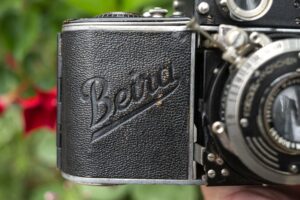
In another episode of “I Didn’t Know That Existed”, I come across a strange looking camera from a company I knew little to nothing about that upon one look, I knew I had to try it out.
The Beier Beira II is without a doubt, a camera unlike any I’ve ever seen. If you were to cross an early Welta or Balda folding camera with a steampunk SLR, you’d kinda come close to what this camera looks like. I suspect a decent number of people who look at photos of the Beira II immediately see the prism hump and assume it is an SLR, and while it does borrow some aspects of ground glass focusing from an SLR, this camera is more of a rangefinder with elements of a TLR merged into a unique looking hybrid camera.
Even if you have no idea who made the Beier II or what kind of camera it is, this camera is unmistakably a 1930s German camera. Its nickel and leather appearance, plus the presence of a rim set Compur Rapid shutter clearly place it right smack in the middle of the 1930s. Build quality is on par with other mid 1930s German cameras, which is to say, very good. The body covering is genuine leather which gives the camera a distinct grip, but also means that it shows scuffs and can start to look ratty after many years of use.
This example is in excellent condition, clearly showing that whoever has owned this camera prior to me took very good care of it. Each of the camera’s metal bits only show the slightest of patina, and the leather body covering is still supple, adding to the gripability of the camera. Quite simply, holding this camera in your hand is a fantastic experience.
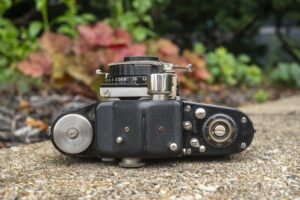
With no manual online, or any full review of this camera for me to learn its controls, I definitely needed to spend extra time fiddling with the camera’s various controls to understand how it worked. Up top, from the left we have the film advance knob. All Beira camera predate the existence of Kodak’s type 135 cassettes and require the use of double perforated 35mm film. This isn’t much of a problem today as regular bulk 35mm film will work fine, but you will need the correct cassettes from this camera to use it. The most important thing to remember is that back then, film was cassette to cassette, so there is no way to rewind film at the end of a roll.
Atop the distinctive prism cover is a screw that, for the life of me, I cannot figure what it does. I have backed it out and tightened it down and I notice no difference in the viewfinder or anywhere else on the camera. I’ve looked at images of other Beira II cameras online and that screw is there, but its function is a mystery. On the opposite side of the prism is a shiny metal button which is the release for the lens and shutter, allowing it to extend into shooting position.
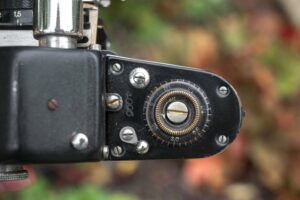
To the right of the prism are several metal bits that need some explaining. The largest, which is in the location you’d expect to see a film advance knob, is the exposure counter. The counter has marks from 1 through 35, suggesting the idea of a 36 exposure cassette wasn’t yet thought of yet. The exposure counter is additive, showing how many exposures has been made and must be reset after loading in each new roll.
Above and to the left of the exposure counter is a threaded screw, which when unscrewed, releases a long shaft with a knife at the end which can be used to cut the film mid roll. This knife works exactly the same as the film knife in the Exakta, and quite possibly could have been the inspiration for that feature on the original Kine Exakta, as all Beiras have it. Below and to the left of the exposure counter is a tear drop shaped pointer and a small button. This point and button are used to advance the film. As film is transported through the camera, the teardrop pointer will rotate. A full exposure of film should rotate the pointer one complete revolution, and then it should lock at an engraved line. Each time the pointer reaches this line, a full exposure has been advanced. In order to continue advancing the film, you must press and hold this button while turning the film advance knob to get to the next exposure. This type of interlock was common in 35mm cameras from the 1930s as models like the Argus C-Series and Wirgin Edixa both had similar controls.
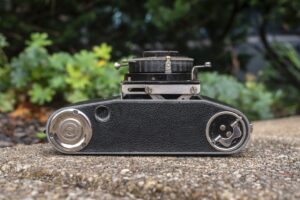
The base of the camera has a couple things that require a little bit of explanation. On the right is a key used to open the reloadable cassettes after loading in a new roll of film. This key works similarly to keys that do the same thing on Leica and Contax cameras of the same era. Simply fold out the handle and turn it. On the other side is a round shaft that can be pulled downward from the bottom of the camera, to release the take up spool within the camera for easier loading. This works exactly as similar features on many roll film cameras do in which you can pull down on the post from the outside of the camera to make inserting or removing an empty spool easier. Next to this shaft is a 3/8″ tripod socket. This size was the common thread size for tripods in the 1930s when this camera was made.
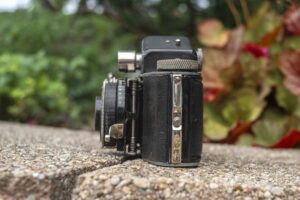
Looking at the sides of the Beier II gives an interesting profile as it sorta resembles a folding bellows SLR, which in a way, it is. On the camera’s left side is a sliding latch for opening the film compartment, but otherwise there is nothing else to see, not even strap lugs.
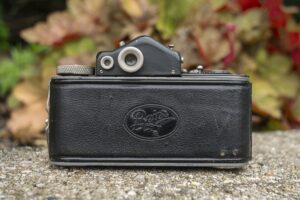
The back of the camera gives you one additional opportunity to admire the unique look of the Beira II’s top plate prism. Two eyepieces are on the back of the camera, the larger of which is for the prism rangefinder and the smaller one for the main viewfinder. In the center of the door is an elegant embossed Beira logo, which is a feature that was very common on 35mm German cameras like the Kodak Retina, Certo Dollina, and other cameras made by Balda and Welta.
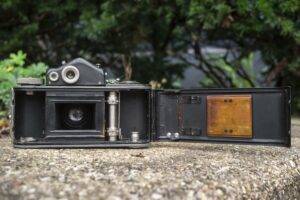
The right hinged film door swings open to reveal the film compartment. The Beira II is based on the original Beira from 1931 which was created before Kodak released their Type 135 cassette for 35mm film. Film transports from right to left onto a special cassette designed for this camera. I did notice that I could make a regular 35mm cassette fit on the supply side on the right, the special cassette was definitely a requirement for the take up side.
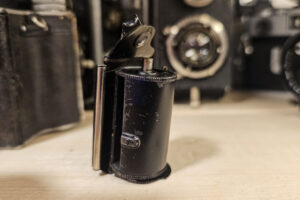
Loading film into the Beira cassette is much like the reloadable cassettes used by the Leica and Contax cameras of the same era in which you open them up, remove and inner spool, attach the film and then reassemble it. The cassettes have a rotating door that opens and closes them allowing you to handle the cassette with the lights on. After inserting the cassette and closing the door, a lock on the bottom of the camera must be rotated to open the cassette, allowing film to be pulled out of the supply cassette. Failure to do this correctly will either result in light damaged film, or film that is badly scratched, or even torn off inside of the camera.
Inside the door is an unpainted brass pressure plate, whcih on this camera has an aged patina that is quite simply, stunning. This is probably a weird thing to say, but the Beier Beira II might have the best looking film pressure plate of any camera I’ve ever seen! To the left of the pressure plate are two clips which help maintain tension on the film as it passes over the sprocket shaft. There are no cloth or foam light seans anywhere in the film compartment to go bad or require replacement.
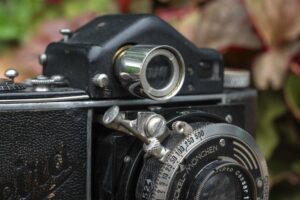
Up front, the Beira II has a pretty normal looking Compur Rapid leaf shutter. Shutter speeds from 1 to 500 are selected via the ring around the perimeter of the shutter, and a sliding lever on the opposite side choose aperture stops from f/2.9 to f/11. Other lenses were available for the Beira, so the actual f/stops shown will vary from lens to lens. To the left of the prism viewfinder’s metal tube is a small button which is used to reset the prism when the camera is focused to infinity. The way you focus this camera is to reset the prism by pushing in this button to move the front window backwards. Then while focusing, it will move outward until you can see a sharp image in the viewfinder. After each image, you should press this button to return the prism to the infinity position.
By far, the most distinctive feature of this camera is something I am not certain belongs here, which is the stubby shutter release screwed into the cable release socket. This shutter release is removable, and I am not certain if this is an accessory some previous owner installed, or if it was available on this camera when new. Whether it is or not, it’s location and short size make reaching it with your right index finger very comfortable. Its location is exactly where your finger naturally falls when holding the camera, which is why I suspect it might be an original feature. But even without this shutter release, you can still fire the Compur Rapid using the normal shutter release lever near the bottom corner.
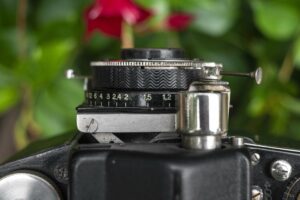
Looking down upon the lens and shutter from the top of the camera is partially obscured by the lens tube sticking out of the front prism. There’s little to see on the shutter itself other than the focus scale, which is indicated from 1 meter to infinity. Beyond that, the Compur’s cocking lever is also seen sticking out from the top of the shutter.
The Beira Beira II has two viewfinders, similar to how a rangefinder would, one for focusing and the other for composing. But the Beira II doesn’t actually have a rangefinder, instead a prism shows a highly magnified cropped circle in the center of the viewed image which is coupled to a moving lens on the front of the camera. This has the effect of working exactly like an SLR, however the image is only a small portion of the center, you still need to use the main viewfinder to compose your image.
What I find extremely interesting about the prism on this camera, is that the designers solved a problem that existed with early prism viewfinders, which is that the image is corrected both for vertical and horizontal orientation. This is contrary to how some early prism viewfinders worked in which the image is only corrected vertically, but not horizontally. So when looking through the prism, if you move the camera to the left, the image moves to the left as you’d expect. Inside the prism viewfinder is a crosshair, which helps to orient the exact center of the image, plus gives you a benchmark for the horizon, even without looking through the main viewfinder. One last interesting thing about the prism viewfinder is that it uses penses similar to a porro prism in which you can only see the full image with your eye perfectly centered. Move your eye even a fraction of a millimeter off center, and you’ll lose the entire image. This is a bit of an issue as sometimes it can take a second to get your eye in that perfect sweet spot, but once you do, the image is very bright and easy to see.
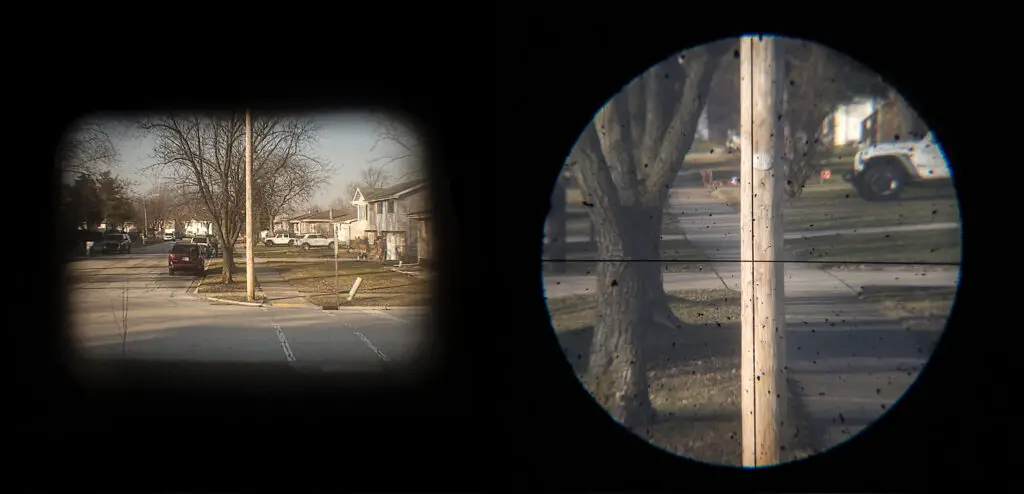
The other viewfinder is a simple straight through optical design which accurately frames a 50mm image. There are no framelines or parallax marks in there, just a rectangle of light. On the plus side however, since there are no beam splitters or anything to dim the image, looking through the viewfinder shows a very bright and contrasty image. Also, I had no problems seeing all four edges of the viewable image, even while wearing prescription glasses. Lastly, the image above showing both the main and prism viewfinders is a composite image. In reality, you cannot ever see both at the same time.
Even before loading in a single roll of film into the Beira II, I could tell this was an infinitely cool camera. Not only does it have very unique and attractive looks, the overall feel of the camera is very high quality. Beier may not have been in the camera making business long, but they succeeded in equalling the typically high standards of the 1930s German camera industry. Not only that, their ability to innovate new features, and come up with new solutions to problems which no one else had done before, is remarkable, making the Beira II one of the coolest cameras you’re likely ever to come across. I can talk all I want about how cool it is, but what kinds of images does it make?
My Results
The day I decided to load up the Beier Beira II with some film, I must have been in a European mood because rather than to with my “first roll mainstay” Kodak TMax 100, I chose a bulk roll of EKFE KB25 which I had received in a lot from a friend. I had shot the EFKE before and found it to be somewhere in between my beloved Kodak Panatomic-X and Rollei RPX25. It has more contrast than the Panatomic, but not at the “near-IR” wavelength as the Rollei. I feel like it is a solid fine grained medium contrast film which despite being of unknown age, still shoots well at box speed. Since the Beier Beira II requires the use of special cassettes, I needed to use bulk film anyway, so I thought why not?!
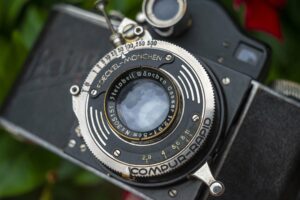
I was more eager to shoot and see my results from the Beria II than I had been in a while for a camera. While I had complete confidence that the Compur Rapid shutter and Steinheil Cassar lens would deliver good quality images, the camera itself was so strange and unique, I had no idea if my attempts to use it would result in any usable shots.
Thankfully, as you can see from above, I did get some great images, and some so so ones. For starters, the 5cm f/2.9 Cassar is a good quality triplet lens, on par with a Schneider Radionar or E. Ludwig Meritar which are all going to deliver images with excellent sharpness in the center, with gradual softness near the edges. That this is an uncoated lens also means that contrast will drop quickly with any bright light source anywhere in the frame.
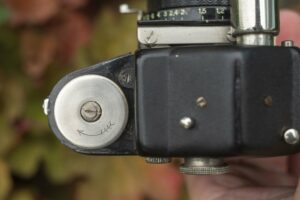
I shot almost the entire roll outdoors with the sky visible and I was impressed at how much contrast remained in the images. I didn’t get that characteristic glow that prewar uncoated lenses usually deliver. The images weren’t as perfect as some kind of fancy 6-element multi-coated lens might have been able to make, but for the era in which this camera was made, I think the Cassar did a great job and made wonderful images with a perfect balance of quality and character.
I shot the entire roll using the focusing prism and my results were mixed. As it turns out, having to keep ‘resetting’ the prism by pushing it back in after each shot proved to be more of a nuisance than I originally thought. In addition, since the prism is coupled to the lens standard, pushing it in with too much force can actually start to retract the lens into the camera, so you must be careful not to use too much strength. It is entirely possible that my experience moving the prism back and forth was impacted by the fact that the camera is nearing its 90th birthday, but overall, I thought it worked pretty well. I just didn’t nail focus on every shot.
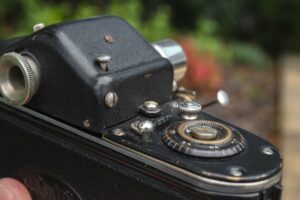
When it did work, the focusing prism was very effective. In some ways, it reminded me a bit of the Corfield Periflex, in which the camera allows you to see focus on a central crop of the exposed image. Its not an SLR, but gives you the same benefit. On the Beira II, the focused image is highly magnified, much more than any rangefinder I’ve ever seen. I could not find out what the magnification ratio is, but I’d have to say it’s at least 4-5x from normal.
I struggled with loading film, but I suspect that’s something you’d get used to after a while and was certainly par for the course when this camera was made. Finally, that you can’t rewind film mid roll is an extra concern as you will almost certainly need to unload this camera in darkness. I did not test out the film knife to try and cut the film mid roll.
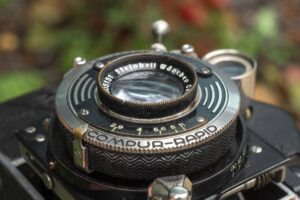
The rest of the camera operated much like a 1930 35mm German camera. You have to remember to release the film transport before each shot, and it lacks double exposure prevention, so you have to remember to advance the film before each shot. Double exposures and even skipped exposures are something that will likely happen to any first time users. Ergonomics are quite good. The camera fit nicely into my hands and with the stubby shutter release cable installed, locating the shutter release with the camera to your eye was very easy. I also appreciated the focus lever that sticks out, which made focusing the camera with it to your eye a pleasure.
It is clear that the people who designed this camera had a lot of great ideas. Certainly, it is a slower to use camera and requires more thought than cameras from later in the 20th century, but for such an early 35mm camera with innovative features that weren’t yet standard in the industry, the Beira II does more right than it does wrong. If I could go back in time and visit the people creating this camera, I would not change a thing as its great looks, thoughtful ergonomics, and very cool and effective focusing prism make for an infinitely cool collectible that is a lot of fun to shoot.
Related Posts You Might Enjoy
External Links
http://camera-wiki.org/wiki/Beira
http://www.cjs-classic-cameras.co.uk/other/beirette.html
https://www.worthpoint.com/worthopedia/beier-beira-okula-1778497950

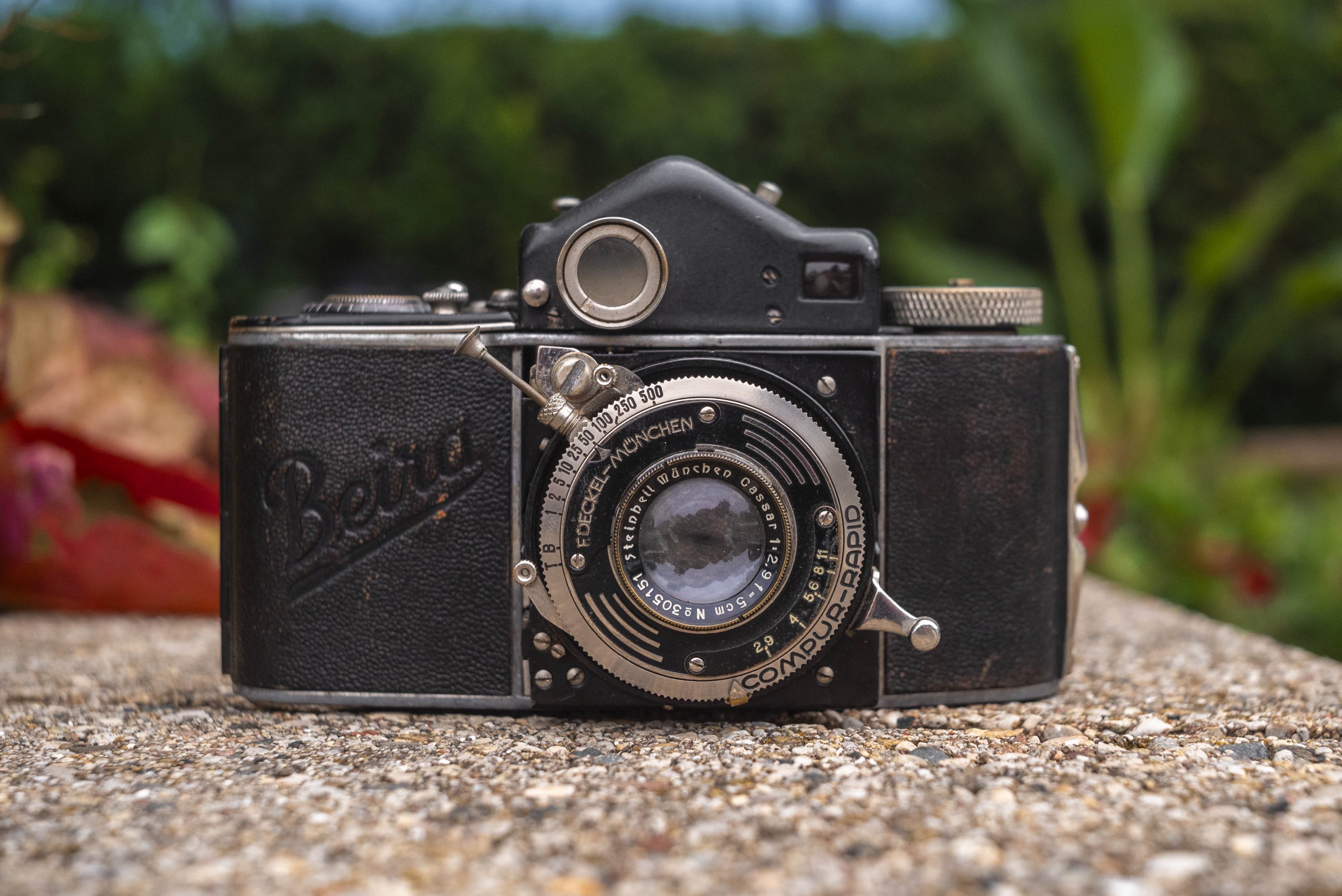
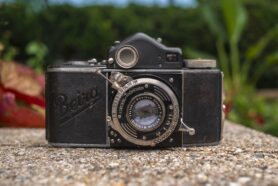
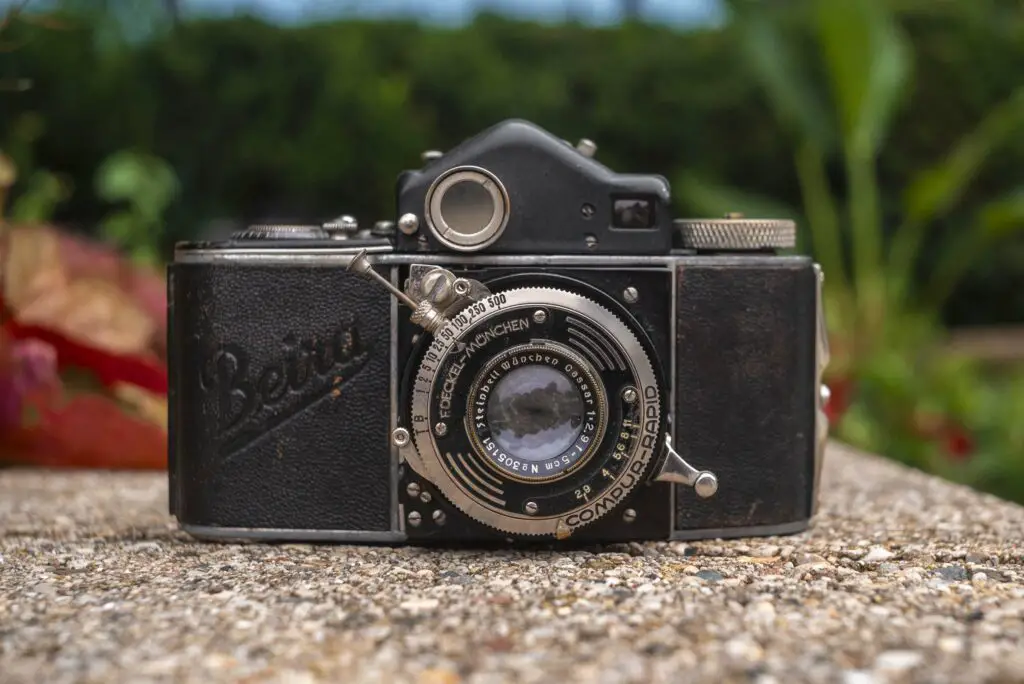
















A steampunk SLR: Love that description! Thanks for a detailed review of a camera I will likely never see in person.
Mike, are the screws on the prism for aligning the RF?
That’s a good possibility. I honestly never tried to turn them as the focus is already correct, and I didn’t want to mess anything up.